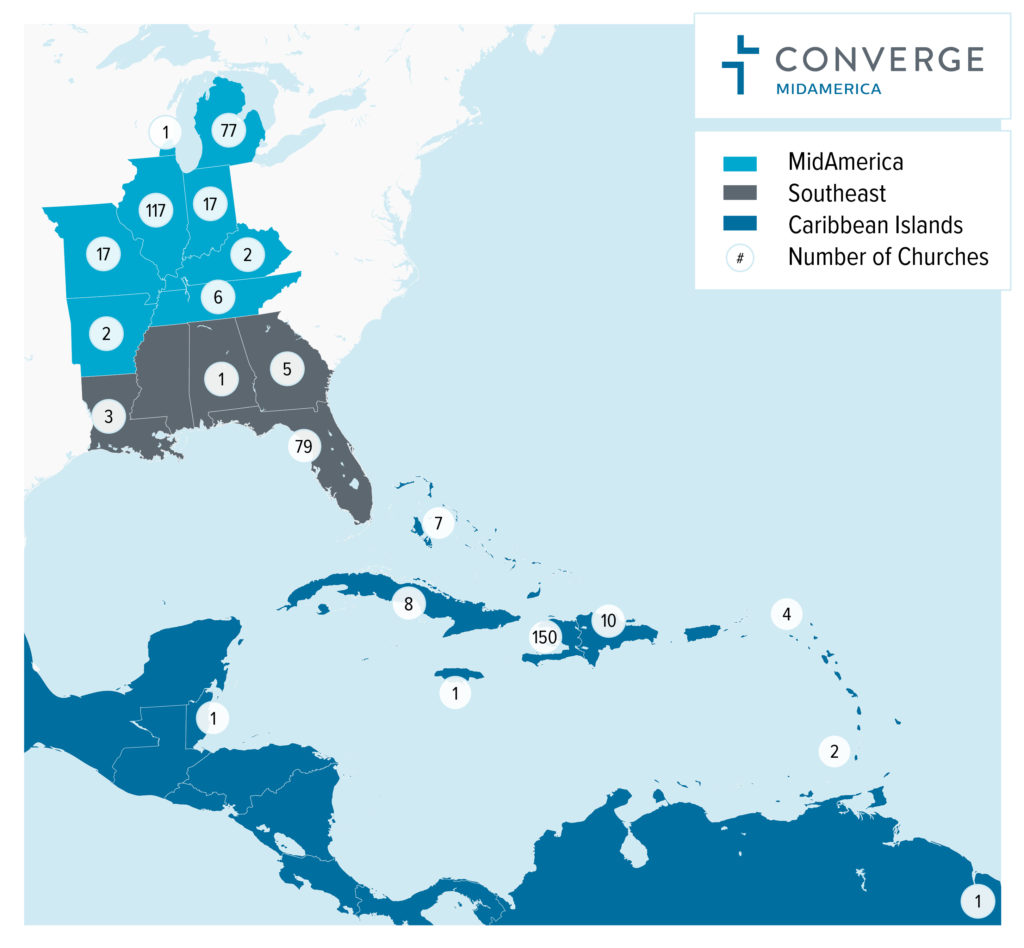Frequently Asked Questions about the Merger
What states make up the Southeast District, how many churches does that constitute, and what is the cultural make-up of the region?

What precipitated the original discussion of a potential merger?
In February of this year, Ernie Cabrera reached out to Gary Rohrmayer and shared the need that Converge Southeast was facing. Gary shared the steps that were taken to facilitate the Michigan/MidAmerica Merger in 2009-10 and recommended that the first step be that the CSE Board send a letter of inquiry to the CMA Board. This letter, after much prayer and consideration by the CSE Board, was sent early May and brought to the attention of the CMA Board at the May board meeting.
In early March, Gary Rohrmayer brought this to the attention of Scott Ridout who shared a few concerns and important issues such as the Caribbean to be a part of the merger and that there would need to be some plan for the region to become autonomous again. Finally, that the other regional leaders were to be made aware of the merger plan.
What were the major issues surrounding the Southeast’s desire to merge?
The major issues were finances, staffing experience and systems. Ever since the financial crash 12 years ago, CSE has struggled to be financially viable even with the financial assistance of Converge National and the other ten Converge Districts throughout the country. This has impacted the district in its ability to staff appropriately and to create and implement needed systems, all of which CMA can bring to the table.
Why would CMA desire to merge?
There are no financial advantages to this merger. CSE has no financial assets, only missional opportunities. To put it in simpler terms: CMA has an opportunity to be neighborly and CSE is asking for our assistance. There were others that offered to help but CSE believes that CMA is the best organization to help them in their time of need. The generosity of CMA churches, CMA’s financial strength, the talent of the administrative and ministry teams, the executive team and Gary Rohrmayer’s 22 years of regional leadership experience all played a key role in CSE’s desire to ask CMA to assist them during this time. With all of this in mind, the CMA Board desires to take this step of faith because we collectively believe that the Holy Spirit is leading us forward in this endeavor and we are seeking the Spirit’s confirmation from our members.
Is this arrangement forever, or is there a plan to “re-separate” the regions?
The Resolution states: “AND FURTHER BE IT RESOLVED, believing it will take 8-10 years for the CSE family of churches to become healthy and vibrant, the CMA board will regularly and prayerfully consider the efficacy and strategic Kingdom value of CSE becoming an independent entity again.”
This issue will be regularly visited by the CMA Board. Nothing would make us happier than to see this region become healthy and financially viable again, but our experience tells us that it is a long-range plan.
Also, we are deliberately choosing to keep each region’s unique identity. Converge MidAmerica will establish two additional entities (DBA), Converge Southeast and Converge Caribbean, that are governed by one board and led by one executive staff team. The cost efficiencies for centralized administration, financial and legal, will allow us to invest more resources into field staff.
What happens to the CMA/CSE staff? Particularly, will we have the same access to staff as we have had in the past?
Yes, every MidAmerica Pastor and lay leader will have access to CMA staff.
CMA’s Church Strengthening and Church Planting Staff will make strategic hires in the Southeast and in MidAmerica that will not only assure the coaching, training and resourcing we currently have, but to see these improved through our systems and services.
Our long-term vision is to have a dedicated church strengthening and church planting person in every region where we have a significant number of churches. As the funding comes in from our churches, we will continue making those hires.
Are there any theological differences between CMA and CSE?
No, every church in each Converge district is committed to upholding Converge’s Affirmation of Faith and the conviction “In Essentials Unity, In Non-Essentials Liberty, In All Things Charity.”
Will there be two regional presidents, or will Gary lead the entire area?
Gary will function as the one regional president. Ernie Cabrera will function on the Executive Team as VP of Church Partnerships. 50% of his time will be working in the area of affiliating churches into the Converge Family. 25% will be focused in Pastoral Care. 25% will be focused on overseeing and expanding the Caribbean mission team. Today there are 3 full-time missionaries serving churches in the Caribbean and we are looking to see that team be expanded.
What will it cost CMA financially to do this merger and will we be able to fund CSE and continue to fund what is going on within CMA?
In 1999 the Converge MidAmerica Board of Overseers made an intentional commitment to spend down the assets they had accumulated over their 165 year history. From 2000-2010 we spent $2,245,000 to see 66 churches planted during that time. In 2010 the Board of Overseers asked Gary Rohrmayer to address this issue. By going to a part-time practioner model in church strengthening and church planting from 2010-2017, the merger with Converge Michigan, the sale of two businesses started in the early 2000’s, a significant donation, and the continual increase of giving from our churches, we had 7 years of positive cash flow and increased our assets $2,350,000 along with seeing 89 churches started in 2010-2018.
The Board of Overseers is prepared to take the same step of faith that it took in 1999 and spend down the necessary assets as a strategic investment into the kingdom of God without hurting the CMA financial position. We are under the conviction that a continual investment in the harvest is the best way to protect our financial future.
This seems to be moving very quickly. Why is that?
The timeline has always been driven by Converge Southeast because of their financial challenges. Recently they have decided to slow down the process, consider all the options in front of them and to develop a thorough communication plan to their churches which led to a new merger timeline.


